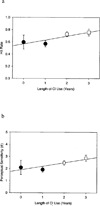Development of visual attention skills in prelingually deaf children who use cochlear implants
- PMID: 16079634
- PMCID: PMC3472625
- DOI: 10.1097/00003446-200508000-00003
Development of visual attention skills in prelingually deaf children who use cochlear implants
Abstract
Objective: To determine the effects of length of cochlear implant use and other demographic factors on the development of sustained visual attention in prelingually deaf children and to examine the relations between performance on a test of sustained visual attention and audiological outcome measures in this population.
Design: A retrospective analysis of data collected before cochlear implantation and over several years after implantation. Two groups of prelingually deaf children, one >6 years old (N = 41) and one <6 years old (N = 47) at testing, were given an age-appropriate Continuous Performance Task (CPT). In both groups, children monitored visually presented numbers for several minutes and responded whenever a designated number appeared. Hit rate, false alarm rate, and signal detection parameters were dependent measures of sustained visual attention. We tested for effects of a number of patient variables on CPT performance. Multiple regression analyses were conducted to determine if CPT scores were related to performance on several audiological outcome measures.
Results: In both groups of children, mean CPT performance was low compared with published norms for normal-hearing children, and performance improved as a function of length of cochlear implant use and chronological age. The improvement in performance was manifested as an increase in hit rate and perceptual sensitivity over time. In the younger age group, a greater number of active electrodes predicted better CPT performance. Results from regression analyses indicated a relationship between CPT response criterion and receptive language in the younger age group. However, we failed to uncover any other relations between CPT performance and speech and language outcome measures.
Conclusions: Our findings suggest that cochlear implantation in prelingually deaf children leads to improved performance on a test of sustained visual processing of numbers over 2 or more years of cochlear implant use. In preschool-age children who use cochlear implants, individuals who are more conservative responders on the CPT show higher receptive language scores than do individuals with more impulsive response patterns. Theoretical accounts of these findings are discussed, including cross-modal reorganization of visual attention and enhanced phonological encoding of visually presented numbers.
Figures




Similar articles
-
Development of audiovisual comprehension skills in prelingually deaf children with cochlear implants.Ear Hear. 2005 Apr;26(2):149-64. doi: 10.1097/00003446-200504000-00004. Ear Hear. 2005. PMID: 15809542 Free PMC article.
-
Speech perception after cochlear implantation over a 4-year time period.Acta Otolaryngol. 2003 Jan;123(2):148-53. doi: 10.1080/0036554021000028111. Acta Otolaryngol. 2003. PMID: 12701730
-
Behavioral inhibition and clinical outcomes in children with cochlear implants.Laryngoscope. 2005 Apr;115(4):595-600. doi: 10.1097/01.mlg.0000161340.00258.1d. Laryngoscope. 2005. PMID: 15805866 Free PMC article.
-
Introduction to cochlear implants.IEEE Eng Med Biol Mag. 1999 Jan-Feb;18(1):32-42. doi: 10.1109/51.740962. IEEE Eng Med Biol Mag. 1999. PMID: 9934598 Review.
-
Speech-processing strategies designed for children.Otolaryngol Head Neck Surg. 1997 Sep;117(3 Pt 1):170-3. doi: 10.1016/s0194-5998(97)70170-0. Otolaryngol Head Neck Surg. 1997. PMID: 9334761 Review.
Cited by
-
Development of visual sustained selective attention and response inhibition in deaf children.Mem Cognit. 2023 Apr;51(3):509-525. doi: 10.3758/s13421-022-01330-1. Epub 2022 Jul 6. Mem Cognit. 2023. PMID: 35794408
-
Executive functioning skills in preschool-age children with cochlear implants.J Speech Lang Hear Res. 2014 Aug;57(4):1521-34. doi: 10.1044/2014_JSLHR-H-13-0054. J Speech Lang Hear Res. 2014. PMID: 24686747 Free PMC article.
-
Attention to speech and spoken language development in deaf children with cochlear implants: a 10-year longitudinal study.Dev Sci. 2018 Nov;21(6):e12677. doi: 10.1111/desc.12677. Epub 2018 May 15. Dev Sci. 2018. PMID: 29761835 Free PMC article.
-
Three challenges for future research on cochlear implants.World J Otorhinolaryngol Head Neck Surg. 2018 Jan 2;3(4):240-254. doi: 10.1016/j.wjorl.2017.12.010. eCollection 2017 Dec. World J Otorhinolaryngol Head Neck Surg. 2018. PMID: 29780970 Free PMC article. Review.
-
Comparisons of IQ in Children With and Without Cochlear Implants: Longitudinal Findings and Associations With Language.Ear Hear. 2018 Nov/Dec;39(6):1187-1198. doi: 10.1097/AUD.0000000000000578. Ear Hear. 2018. PMID: 29624538 Free PMC article.
References
-
- Baddeley A, Gathercole S, Papagno C. The phonological loop as a language learning device. Psychological Review. 1998;105:158–173. - PubMed
-
- Barkley R. The ecological validity of laboratory and analogue assessment methods of ADHD symptoms. Journal of Abnormal Child Psychology. 1991;19:149–178. - PubMed
-
- Blamey P, Sarant J, Paatsch L, Barry J, Bow C, Wales R, et al. Relationships among speech perception, production, language, hearing loss, and age in children with impaired hearing. Journal of Speech, Language, Hearing, Research. 2001;44:264–285. - PubMed
Publication types
MeSH terms
Grants and funding
LinkOut - more resources
Full Text Sources
Medical

